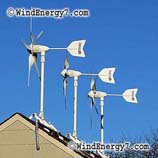Monday, July 7th, 2008
.
.
Beginning in the year 2007, when both turbines are paid for, the Spirit Lake Community Schools district will have about $120,000 tax free income from the clean, renewable northwest Iowa wind to use to improve education for the children of the Spirit Lake Community School District.
The visionary leaders at Spirit Lake Community Schools began studying the use of wind as a renewable source of energy for the district in September of 1991. Early in the study a partnership was formed with the Iowa Department of Natural Resources.
In the following year, data was collected to:
>- Measure the wind speed on the proposed site
>- Analyze the districts electrical costs
>- Get acquainted with wind turbine manufacturing
>- Understand both federal and state rules and regulations
>- Study existing wind turbine sites
The study revealed a strong indication of total investment return in 8.5 years.
Once the vision was established, Spirit Lake Community Schools applied for a grant from the Department of Energy for three turbines; one each for the elementary, middle and high school. The high school was rejected because of the cost of the conversion necessary to switch from a different electrical phase. The middle school was rejected because the DOE does not fund new buildings. In December 1992, the elementary school received a grant for $119,000 for one turbine to supply electrical energy.
Specifications for the wind turbine were prepared and three bids were received in the spring of 1993. The successful bidder was Minnesota Wind Power of Marshall, Minnesota with a bid to provide and install one wind generator at a cost of $239,500.
To offset the additional cost not covered by the DOE grant, the project was funded by a low interest loan through the Energy Council of the Department of Natural Resources.
Payoff Comes Swiftly
On July 22, 1993, the wind turbine on the lawn of the Spirit Lake Elementary School began producing electricity. Ninety months later, the school’s turbine had produced 1,570,000 kilowatt hours of electricity which would have cost the district $124,900. This is enough electricity for 264 average Spirit Lake homes for a year. In addition to providing all of the electricity for the 53,000 square foot elementary school, it also produced a reimbursement from the utility company of almost $25,000.
The final payment for the loan on turbine was made during 1998, 3.5 years ahead of schedule. Today the almost $25,000 savings go to the school’s instructional program.
How Wind Energy Works
The props turn whenever there is wind. It generates electricity after the generator turns at 1790 rpm, which requires a wind of around 7.5 mph at the 140 foot level.
The system is being monitored constantly in several ways. The primary method is by computer from the office of the district’s Director of Buildings and Grounds, Mr. Jim Tirevold. The computer monitors wind speed, electricity being produced in real time for the day, in addition to cumulative totals.
As of July 1, 2004, the turbine has generated on average 312,309 kWh of electricity annually. To generate an equivalent amount of electricity, it would take 549 barrels of oil or 156 tons of coal. It would take 285 trees to absorb the carbon dioxide emitted by this oil or coal.
There is no storage capacity. During peak demand and /or low winds the district purchases electricity from Alliant Energy and during excess production, Alliant Energy purchases electricity from the school. The district utilizes net billing. Currently, if the district uses less than what is produced Alliant will purchase the excess energy for 6.02 cents. If the district uses more than produced, Alliant sells to us for 8.5 cents.
Farming the Wind
In addition to its excellent financial success, the school’s wind turbine has been used in school classes as an educational tool and it has made a significant contribution to the environment. The district has had over 400 visitors since that warm day in July of 1993 when the turbine began producing. A number of schools in the area and their students have shown particular interest in the project as they study the use of renewable sources of energy.
A Second Turbine is Added
Once it was established that the wind turbine had indeed been a great success and asset to the district, plans went quickly into effect for the second turbine. On October 29, 2001, the NEG Micon 750 KWH tubular tower turbine became operational and was well on its way to providing power for the entire school district.
The NEG Micon has an anticipated life span of 30 years. It stands 25 feet taller than the original turbine on a 165-foot base. The wingspan is almost double the size of the Windworld turbine at 157 feet in diameter compared to 87 feet. The size of the rotor diameter is approximately that of the wing space of a DC-10 jumbo jet, and it is designed to withstand hurricane type wind speeds of 131 mph. The new turbine will not only provide energy for all of the remaining school facilities and athletic fields, but also an additional educational resource for Spirit Lake students.
The district borrowed $780,00 to complete the installation of the turbine, and anticipates a 6 V2 year pay back period. The energy bills offset each year equal approximately $118,000, which can be used for other district programs after the 6 V2 year period is complete. The financing of the turbine included a $250,000 no-interest loan from the Iowa Energy Center and a $580,000 Iowa Department of Natural Energy loan from a commercial bank with interest at 5.1%.
To Buy a Wind Turbine or Become a Dealer, Please fill out our Contact Form. The system will automatically send you some additional info.





